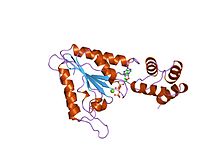AAA protein
| ATPases associated with diverse cellular activities (AAA) | |||||||||
|---|---|---|---|---|---|---|---|---|---|

Structure of N-ethylmaleimide-sensitive factor.
|
|||||||||
| Identifiers | |||||||||
| Symbol | AAA | ||||||||
| Pfam | PF00004 | ||||||||
| Pfam clan | CL0023 | ||||||||
| InterPro | IPR003959 | ||||||||
| PROSITE | PDOC00572 | ||||||||
| SCOP | 1nsf | ||||||||
| SUPERFAMILY | 1nsf | ||||||||
| CDD | cd00009 | ||||||||
|
|||||||||
| Available protein structures: | |
|---|---|
| Pfam | structures |
| PDB | RCSB PDB; PDBe; PDBj |
| PDBsum | structure summary |
AAA or AAA+ is an abbreviation for ATPases Associated with diverse cellular Activities. They share a common conserved module of approximately 230 amino acid residues. This is a large, functionally diverse protein family belonging to the AAA superfamily of ring-shaped P-loop NTPases, which exert their activity through the energy-dependent remodeling or translocation of macromolecules.
AAA proteins couple chemical energy provided by ATP hydrolysis to conformational changes which are transduced into mechanical force exerted on a macromolecular substrate.
AAA proteins are functionally and organizationally diverse, and vary in activity, stability, and mechanism. Members of the AAA family are found in all organisms and they are essential for many cellular functions. They are involved in processes such as DNA replication, protein degradation, membrane fusion, microtubule severing, peroxisome biogenesis, signal transduction and the regulation of gene expression.
The AAA domain contains two subdomains, an N-terminal alpha/beta domain that binds and hydrolyzes nucleotides (a Rossman fold) and a C-terminal alpha-helical domain. The N-terminal domain is 200-250 amino acids long and contains Walker A and Walker B motifs, and is shared in common with other P-loop NTPases, the superfamily which includes the AAA family. Most AAA proteins have additional domains that are used for oligomerization, substrate binding and/or regulation. These domains can lie N- or C-terminal to the AAA module.
Some classes of AAA proteins have an N-terminal non-ATPase domain which is followed by either one or two AAA domains (D1 and D2). In some proteins with two AAA domains, both are evolutionarily well conserved (like in Cdc48/p97). In others, either the D2 domain (like in Pex1p and Pex6p) or the D1 domain (in Sec18p/NSF) is better conserved in evolution.
While the classical AAA family was based on motifs, the family has been expanded using structural information and is now termed the AAA family.
AAA proteins are divided into seven basic clades, based on secondary structure elements included within or near the core AAA fold: clamp loader, initiator, classic, superfamily III helicase, HCLR, H2-insert, and PS-II insert.
...
Wikipedia
